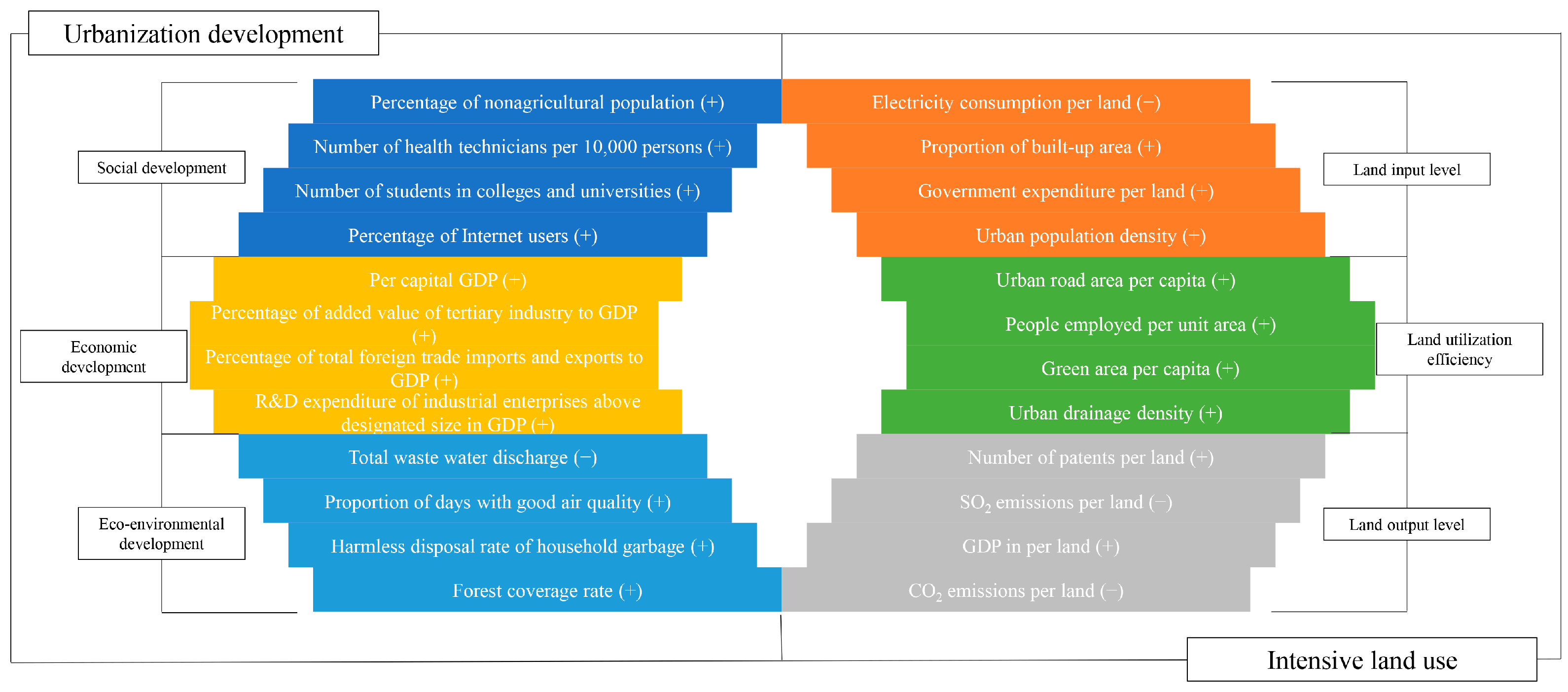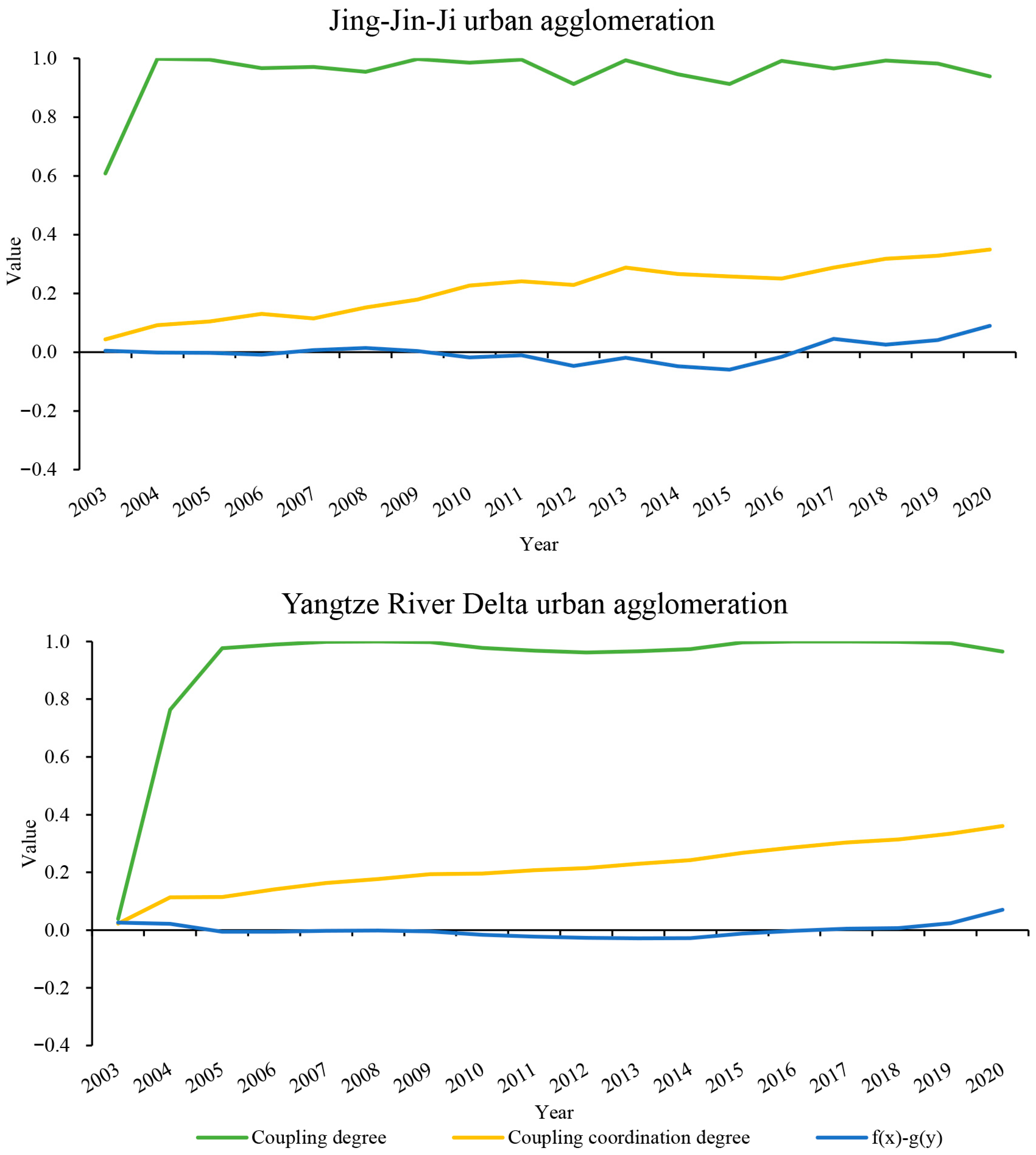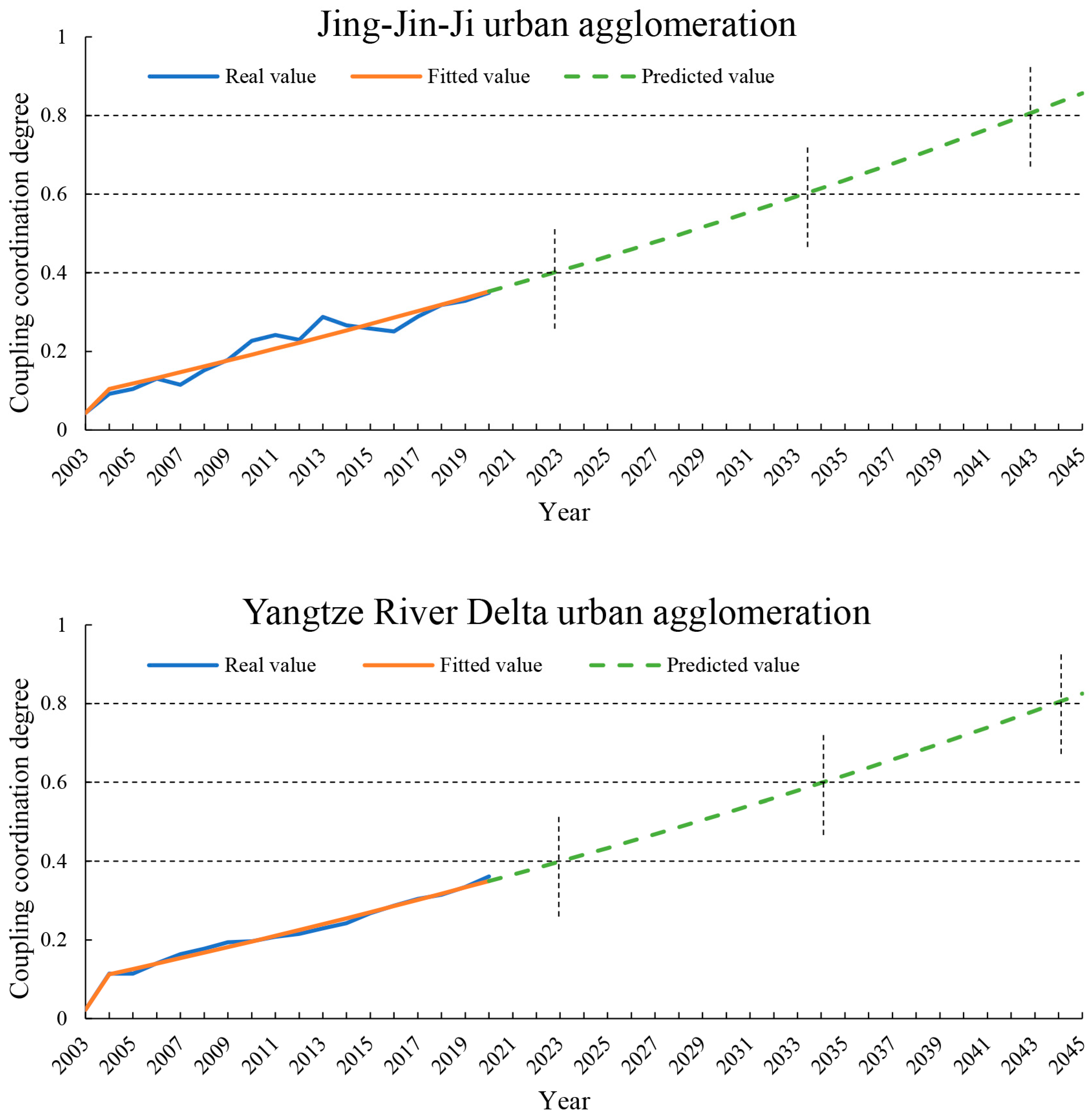Urban Agglomerations Promote the Coordinated Development of Urbanization and Intensive Land Use
Abstract
1. Introduction
2. Materials and Methods
2.1. Study Area, Index System and Data Source
2.2. Methodology
2.2.1. The Entropy Weight Method
2.2.2. The CG-GSO Model
2.2.3. The Coupling Coordination Degree Model
2.2.4. Gray Prediction Model GM (1,1)
3. Results
3.1. Urbanization Development Subsystem
3.2. Intensive Land Use Subsystem
3.3. Coordination Development Level of the Coupling System
3.4. Analysis of Driving Factors
4. Discussion and Policy Implications
4.1. Urbanization, Intensive Land Use, and the Coupling System
4.2. Prediction of Coupling Coordination Degree
4.3. Policy Implications
5. Conclusions
Author Contributions
Funding
Data Availability Statement
Conflicts of Interest
References
- Sahana, M.; Hong, H.; Sajjad, H. Analyzing urban spatial patterns and trend of urban growth using urban sprawl matrix: A study on Kolkata urban agglomeration, India. Sci. Total Environ. 2018, 628–629, 1557–1566. [Google Scholar] [CrossRef] [PubMed]
- Jiang, S.; Meng, J.; Zhu, L.; Cheng, H. Spatial-temporal pattern of land use conflict in China and its multilevel driving mechanisms. Sci. Total Environ. 2021, 801, 149697. [Google Scholar] [CrossRef]
- Lyu, Y.; Wang, M.; Zou, Y.; Wu, C. Mapping trade-offs among urban fringe land use functions to accurately support spatial planning. Sci. Total Environ. 2022, 802, 149915. [Google Scholar] [CrossRef]
- Zhao, M.; Cheng, C.; Zhou, Y.; Li, X.; Shen, S.; Song, C. A global dataset of annual urban extents (1992–2020) from harmonized nighttime lights. Earth Syst. Sci. Data Discuss. 2022, 14, 517–534. [Google Scholar] [CrossRef]
- Mishra, A.; Humpenöder, F.; Churkina, G.; Reyer, C.P.O.; Beier, F.; Bodirsky, B.L.; Schellnhuber, H.J.; Lotze-Campen, H.; Popp, A. Land use change and carbon emissions of a transformation to timber cities. Nat. Commun. 2022, 13, 4889. [Google Scholar] [CrossRef] [PubMed]
- Ren, Q.; He, C.; Huang, Q.; Shi, P.; Zhang, D.; Güneralp, B. Impacts of urban expansion on natural habitats in global drylands. Nat. Sustain. 2022, 5, 869–878. [Google Scholar] [CrossRef]
- Gao, J.; O’Neill, B.C. Mapping global urban land for the 21st century with data-driven simulations and Shared Socioeconomic Pathways. Nat. Commun. 2020, 11, 2302. [Google Scholar] [CrossRef]
- Fleischmann, M.; Arribas-Bel, D. Geographical characterisation of British urban form and function using the spatial signatures framework. Sci. Data 2022, 9, 546. [Google Scholar] [CrossRef]
- Kukulska-Kozieł, A.; Szylar, M.; Cegielska, K.; Noszczyk, T.; Hernik, J.; Gawroński, K.; Dixon-Gough, R.; Jombach, S.; Valánszki, I.; Filepné Kovács, K. Towards three decades of spatial development transformation in two con-trasting post-Soviet cities—Kraków and Budapest. Land Use Policy 2019, 85, 328–339. [Google Scholar] [CrossRef]
- Zhou, B.; Rybski, D.; Kropp, J.P. On the statistics of urban heat island intensity. Geophys. Res. Lett. 2013, 40, 5486–5491. [Google Scholar] [CrossRef]
- Fragkias, M.; Seto, K.C. Evolving rank-size distributions of intra-metropolitan urban clusters in South China. Comput. Environ. Urban Syst. 2009, 33, 189–199. [Google Scholar] [CrossRef]
- Soga, M.; Yamaura, Y.; Koike, S.; Gaston, K.J. Land sharing vs. land sparing: Does the compact city reconcile urban development and biodiversity conservation? J. Appl. Ecol. 2014, 51, 1378–1386. [Google Scholar] [CrossRef]
- He, X. Energy effect of urban diversity: An empirical study from a land-use perspective. Energy Econ. 2022, 108, 105892. [Google Scholar] [CrossRef]
- Cui, X.; Li, S.; Wang, X.; Xue, X. Driving factors of urban land growth in Guangzhou and its implications for sustainable development. Front. Earth Sci. 2018, 13, 464–477. [Google Scholar] [CrossRef]
- Ye, X.; Dong, L.; Lv, L.; Shang, Y. Spatiotemporal evolution law and driving force of mining city patterns. Environ. Sci. Pollut. Res. 2021, 29, 10291–10307. [Google Scholar] [CrossRef] [PubMed]
- Liu, C.; Wang, T.; Guo, Q. Factors Aggregating Ability and the Regional Differences among China’s Urban Agglomerations. Sustainability 2018, 10, 4179. [Google Scholar] [CrossRef]
- Lu, X.; Zhang, Y.; Li, J.; Duan, K. Measuring the urban land use efficiency of three urban agglomerations in China under carbon emissions. Environ. Sci. Pollut. Res. 2022, 29, 36443–36474. [Google Scholar] [CrossRef] [PubMed]
- Niu, B.; Ge, D.; Yan, R.; Ma, Y.; Sun, D.; Lu, M.; Lu, Y. The Evolution of the Interactive Relationship between Urbanization and Land-Use Transition: A Case Study of the Yangtze River Delta. Land 2021, 10, 804. [Google Scholar] [CrossRef]
- Zhou, Y.; Chen, M.; Tang, Z.; Mei, Z. Urbanization, land use change, and carbon emissions: Quantitative assessments for city-level carbon emissions in Beijing-Tianjin-Hebei region. Sustain. Cities Soc. 2021, 66, 102701. [Google Scholar] [CrossRef]
- Surya, B.; Salim, A.; Hernita, H.; Suriani, S.; Menne, F.; Rasyidi, E.S. Land Use Change, Urban Agglomeration, and Urban Sprawl: A Sustainable Development Perspective of Makassar City, Indonesia. Land 2021, 10, 556. [Google Scholar] [CrossRef]
- Cabral, P.; Santos, J.A.; Augusto, G. Monitoring Urban Sprawl and the National Ecological Reserve in Sintra-Cascais, Portugal: Multiple OLS Linear Regression Model Evaluation. J. Urban Plan. Dev. 2011, 137, 346–353. [Google Scholar] [CrossRef]
- Omoke, P.C.; Nwani, C.; Effiong, E.L.; Evbuomwan, O.O.; Emenekwe, C.C. The impact of financial development on carbon, non-carbon, and total ecological footprint in Nigeria: New evidence from asymmetric dynamic analysis. Environ. Sci. Pollut. Res. 2020, 27, 21628–21646. [Google Scholar] [CrossRef] [PubMed]
- Tandon, A.; Verma, P.R. Human population induced urban developments and their effects on temperature rise: A nonlinear mathematical model. Ecol. Complex. 2021, 47, 100947. [Google Scholar] [CrossRef]
- Li, X.; Lu, Z. Quantitative measurement on urbanization development level in urban Agglomerations: A case of JJJ urban ag-glomeration. Ecol. Indic. 2021, 133, 108375. [Google Scholar] [CrossRef]
- Wang, Y.; Liu, H.; Mao, G.; Zuo, J.; Ma, J. Inter-regional and sectoral linkage analysis of air pollution in Beijing–Tianjin–Hebei (Jing-Jin-Ji) urban agglomeration of China. J. Clean. Prod. 2017, 165, 1436–1444. [Google Scholar] [CrossRef]
- Chen, W.; Wu, S.; Lei, Y.; Li, S. Interprovincial transfer of embodied energy between the Jing-Jin-Ji area and other provinces in China: A quantification using interprovincial input-output model. Sci. Total Environ. 2017, 584–585, 990–1003. [Google Scholar] [CrossRef] [PubMed]
- Fang, C.; Lin, X. The eco-environmental guarantee for China’s urbanization process. J. Geogr. Sci. 2009, 19, 95–106. [Google Scholar] [CrossRef]
- Yang, Z.; Li, S.; Sun, D.; Li, C.; Wu, J. Intensive Evaluation and High-Quality Redevelopment of Enterprise Land Use: A Case Study in China. Land 2022, 11, 432. [Google Scholar] [CrossRef]
- Aras, G.; Tezcan, N.; Furtuna, O.K. Multidimensional comprehensive corporate sustainability performance evaluation model: Evidence from an emerging market banking sector. J. Clean. Prod. 2018, 185, 600–609. [Google Scholar] [CrossRef]
- Olsson, G. Explanation, Prediction, and Meaning Variance: An Assessment of Distance Interaction Models. Econ. Geogr. 1970, 46, 223–233. [Google Scholar] [CrossRef]
- Ewing, G.O. Gravity and Linear Regression Models of Spatial Interaction: A Cautionary Note. Econ. Geogr. 1974, 50, 83–88. [Google Scholar] [CrossRef]
- Li, Y.; Ye, H.; Gao, X.; Sun, D.; Li, Z.; Zhang, N.; Leng, X.; Meng, D.; Zheng, J. Spatiotemporal Patterns of Urbanization in the Three Most Developed Urban Agglomerations in China Based on Con-tinuous Nighttime Light Data (2000–2018). Remote Sens. 2021, 13, 2245. [Google Scholar] [CrossRef]
- Li, X.; Lu, Z.; Gao, S.; Wang, Y.; Zhang, M. Will city cluster cope with water dilemma? J. Clean. Prod. 2022, 371, 133548. [Google Scholar] [CrossRef]
- Liang, W.; Yang, M. Urbanization, economic growth and environmental pollution: Evidence from China. Sustain. Comput. Inform. Syst. 2019, 21, 1–9. [Google Scholar] [CrossRef]
- Peng, C.; Song, M.; Han, F. Urban economic structure, technological externalities, and intensive land use in China. J. Clean. Prod. 2017, 152, 47–62. [Google Scholar] [CrossRef]
- Cheng, X.; Shao, H.; Li, Y.; Shen, C.; Liang, P. Urban Land Intensive Use Evaluation Study Based on Nighttime Light—A Case Study of the Yangtze River Economic Belt. Sustainability 2019, 11, 675. [Google Scholar] [CrossRef]
- Bai, Y.; Zheng, H.; Shan, Y.; Meng, J.; Li, Y. The Consumption-Based Carbon Emissions in the Jing-Jin-Ji Urban Agglomeration Over China’s Economic Transition. Earth’s Future 2021, 9, e2021EF002132. [Google Scholar] [CrossRef]
- Sun, Y.; Zhao, S. Spatiotemporal dynamics of urban expansion in 13 cities across the Jing-Jin-Ji Urban Agglomeration from 1978 to 2015. Ecol. Indic. 2018, 87, 302–313. [Google Scholar] [CrossRef]
- Haas, J.; Ban, Y. Urban growth and environmental impacts in Jing-Jin-Ji, the Yangtze, River Delta and the Pearl River Delta. Int. J. Appl. Earth Obs. Geoinf. 2014, 30, 42–55. [Google Scholar] [CrossRef]
- Wang, J.; Dong, X.; Dong, K. How does ICT agglomeration affect carbon emissions? The case of Yangtze River Delta urban ag-glomeration in China. Energy Econ. 2022, 111, 106107. [Google Scholar] [CrossRef]
- Gao, J. How China will protect one-quarter of its land. Nature 2019, 569, 457. [Google Scholar] [CrossRef]
- Yang, Y.; Qu, S.; Cai, B.; Liang, S.; Wang, Z.; Wang, J.; Xu, M. Mapping global carbon footprint in China. Nat. Commun. 2020, 11, 2237. [Google Scholar] [CrossRef]
- Guo, S.; Wang, Y.; Wang, Y.; Wang, M.; He, P.; Feng, L. Inequality and collaboration in north China urban agglomeration: Evidence from embodied cultivated land in Jing-Jin-Ji’s interregional trade. J. Environ. Manag. 2020, 275, 111050. [Google Scholar] [CrossRef]
- Geng, Y.; Zhang, H. Coordination assessment of environment and urbanization: Hunan case. Environ. Monit. Assess. 2020, 192, 637. [Google Scholar] [CrossRef]
- Li, X.; Lu, Z.; Hou, Y.; Zhao, G.; Zhang, L. The coupling coordination degree between urbanization and air environment in the Beijing(Jing)-Tianjin(Jin)-Hebei(Ji) urban agglomeration. Ecol. Indic. 2022, 137, 108787. [Google Scholar] [CrossRef]
- Sheng, X.; Cao, Y.; Zhou, W.; Zhang, H.; Song, L. Multiple scenario simulations of land use changes and countermeasures for collaborative development mode in Chaobai River region of Jing-Jin-Ji, China. Habitat Int. 2018, 82, 38–47. [Google Scholar] [CrossRef]
- Wu, W.; Zhao, S.; Zhu, C.; Jiang, J. A comparative study of urban expansion in Beijing, Tianjin and Shijiazhuang over the past three decades. Landsc. Urban Plan. 2015, 134, 93–106. [Google Scholar] [CrossRef]
- Chi, J.; Xu, G.; Yang, Q.; Liu, Y.; Sun, J. Evolutionary characteristics of ecosystem services and ecological risks at highly developed economic region: A case study on Yangtze River Delta, China. Environ. Sci. Pollut. Res. 2022, 30, 1152–1166. [Google Scholar] [CrossRef]
- Shen, S.; Yue, P.; Fan, C. Quantitative assessment of land use dynamic variation using remote sensing data and landscape pattern in the Yangtze River Delta, China. Sustain. Comput. Inform. Syst. 2019, 23, 111–119. [Google Scholar] [CrossRef]
- Lichtenberg, E.; Ding, C. Assessing farmland protection policy in China. Land Use Policy 2008, 25, 59–68. [Google Scholar] [CrossRef]
- Zhang, Z.; Huisingh, D. Combating desertification in China: Monitoring, control, management and revegetation. J. Clean. Prod. 2018, 182, 765–775. [Google Scholar] [CrossRef]
- Groff, S.P.; Rau, S. China’s City Clusters: Pioneering Future Mega-Urban Governance; American Affairs: Boston, MA, USA, 2019. [Google Scholar]
- Dadashpoor, H.; Azizi, P.; Moghadasi, M. Land use change, urbanization, and change in landscape pattern in a metropolitan area. Sci. Total Environ. 2019, 655, 707–719. [Google Scholar] [CrossRef]
- Fang, Z.; Ding, T.; Chen, J.; Xue, S.; Zhou, Q.; Wang, Y.; Wang, Y.; Huang, Z.; Yang, S. Impacts of land use/land cover changes on ecosystem services in ecologically fragile regions. Sci. Total Environ. 2022, 831, 154967. [Google Scholar] [CrossRef] [PubMed]
- Zhou, X.-X.; Zhu, Z.-H.; Feng, C. The evolution of land policies in China from 1980 to 2019: A policy-text based analysis. Environ. Sci. Pollut. Res. 2022, 29, 54902–54915. [Google Scholar] [CrossRef] [PubMed]
- Krigsholm, P.; Puustinen, T.; Falkenbach, H. Understanding variation in municipal land policy strategies: An empirical typology. Cities 2022, 126, 103710. [Google Scholar] [CrossRef]









| Dimension | Indicators | Explanation |
|---|---|---|
| LIL | Fixed asset investment per land | Real estate development enterprises complete investment (100 million yuan)/urban area (square kilometers) |
| Proportion of built-up area | Built-up area (square kilometers)/urban area (square kilometers) | |
| Government expenditure per land | General budget expenditure of local finance (100 million yuan)/urban area (square kilometers) | |
| People employed per unit area | Employed person in urban units (ten thousand persons)/urban area (square kilometers) | |
| LUE | Urban road area per capita | Urban road area per person (square meters) |
| Urban population density | Urban population (ten thousand persons/square kilometers) | |
| Green area per capita | Urban green area (ten thousand square meters)/resident population in year-end (ten thousand persons) | |
| Urban drainage density | Length of urban drainage pipes (kilometer)/built-up area (square kilometers) | |
| LOL | Secondary and tertiary industries added value construction land occupation | Added value of secondary and tertiary industries (ten thousand yuan)/construction land area (square kilometers) |
| Total retail sales per capita | Total retail consumption (ten thousand yuan)/urban land area (square kilometers) | |
| GDP in per land | GDP (ten thousand yuan)/urban land area (square kilometers) | |
| Green coverage rate of built-up area | Green area (square kilometers)/built-up area (square kilometers) |
| Value | C | D | Difference | Description of Classification |
|---|---|---|---|---|
| (0.0, 0.2] | Extreme decoupling development | Extreme unbalanced development | f(x) > g(y) | Lagging intensive land use subsystem |
| g(y) > f(x) | Lagging urbanization development subsystem | |||
| −0.1 ≤ f(x) − g(y) ≤ 0.1 | Parallel development of two subsystems | |||
| (0.2, 0.4] | Moderate decoupling development | Moderate unbalanced development | f(x) > g(y) | Lagging intensive land use subsystem |
| g(y) > f(x) | Lagging urbanization development subsystem | |||
| −0.1 ≤ f(x) − g(y) ≤ 0.1 | Parallel development of two subsystems | |||
| (0.4, 0.6] | Slightly coupling development | Slightly balanced development | f(x) > g(y) | Lagging intensive land use subsystem |
| g(y) > f(x) | Lagging urbanization development subsystem | |||
| −0.1 ≤ f(x) − g(y) ≤ 0.1 | Parallel development of two subsystems | |||
| (0.6, 0.8] | Barely coupling development | Barely balanced development | f(x) > g(y) | Lagging intensive land use subsystem |
| g(y) > f(x) | Lagging urbanization development subsystem | |||
| −0.1 ≤ f(x) − g(y) ≤ 0.1 | Parallel development of two subsystems | |||
| (0.8, 1.0] | Superiorly coupling development | Superiorly balanced development | f(x) > g(y) | Lagging intensive land use subsystem |
| g(y) > f(x) | Lagging urbanization development subsystem | |||
| −0.1 ≤ f(x) − g(y) ≤ 0.1 | Parallel development of two subsystems |
| Region | Subsystem | Dimension | Weight |
|---|---|---|---|
| JJJ UA | Urbanization development | SOD | 0.3250 |
| ECD | 0.5595 | ||
| EED | 0.1155 | ||
| Intensive land use | LIL | 0.4530 | |
| LUE | 0.2734 | ||
| LOL | 0.2736 | ||
| YRD UA | Urbanization development | SODt | 0.2333 |
| ECD | 0.5259 | ||
| EED | 0.2408 | ||
| Intensive land use | LIL | 0.3508 | |
| LUE | 0.2780 | ||
| LOL | 0.3712 |
| a | b | C | ρ | RMSE | REmax | DSRmax | |
|---|---|---|---|---|---|---|---|
| JJJ UA | −0.0127 | 1.0841 | 0.0599 | 1.0000 | 0.0220 | 20.0000% | 0.2000 |
| YRD UA | −0.0121 | 1.0932 | 0.0077 | 1.0000 | 0.0080 | 9.7590% | 0.1760 |
Disclaimer/Publisher’s Note: The statements, opinions and data contained in all publications are solely those of the individual author(s) and contributor(s) and not of MDPI and/or the editor(s). MDPI and/or the editor(s) disclaim responsibility for any injury to people or property resulting from any ideas, methods, instructions or products referred to in the content. |
© 2025 by the authors. Licensee MDPI, Basel, Switzerland. This article is an open access article distributed under the terms and conditions of the Creative Commons Attribution (CC BY) license (https://creativecommons.org/licenses/by/4.0/).
Share and Cite
Zhang, M.; Li, X.; Lu, Z. Urban Agglomerations Promote the Coordinated Development of Urbanization and Intensive Land Use. Land 2025, 14, 2231. https://doi.org/10.3390/land14112231
Zhang M, Li X, Lu Z. Urban Agglomerations Promote the Coordinated Development of Urbanization and Intensive Land Use. Land. 2025; 14(11):2231. https://doi.org/10.3390/land14112231
Chicago/Turabian StyleZhang, Meng, Xiaoyang Li, and Zhaohua Lu. 2025. "Urban Agglomerations Promote the Coordinated Development of Urbanization and Intensive Land Use" Land 14, no. 11: 2231. https://doi.org/10.3390/land14112231
APA StyleZhang, M., Li, X., & Lu, Z. (2025). Urban Agglomerations Promote the Coordinated Development of Urbanization and Intensive Land Use. Land, 14(11), 2231. https://doi.org/10.3390/land14112231





